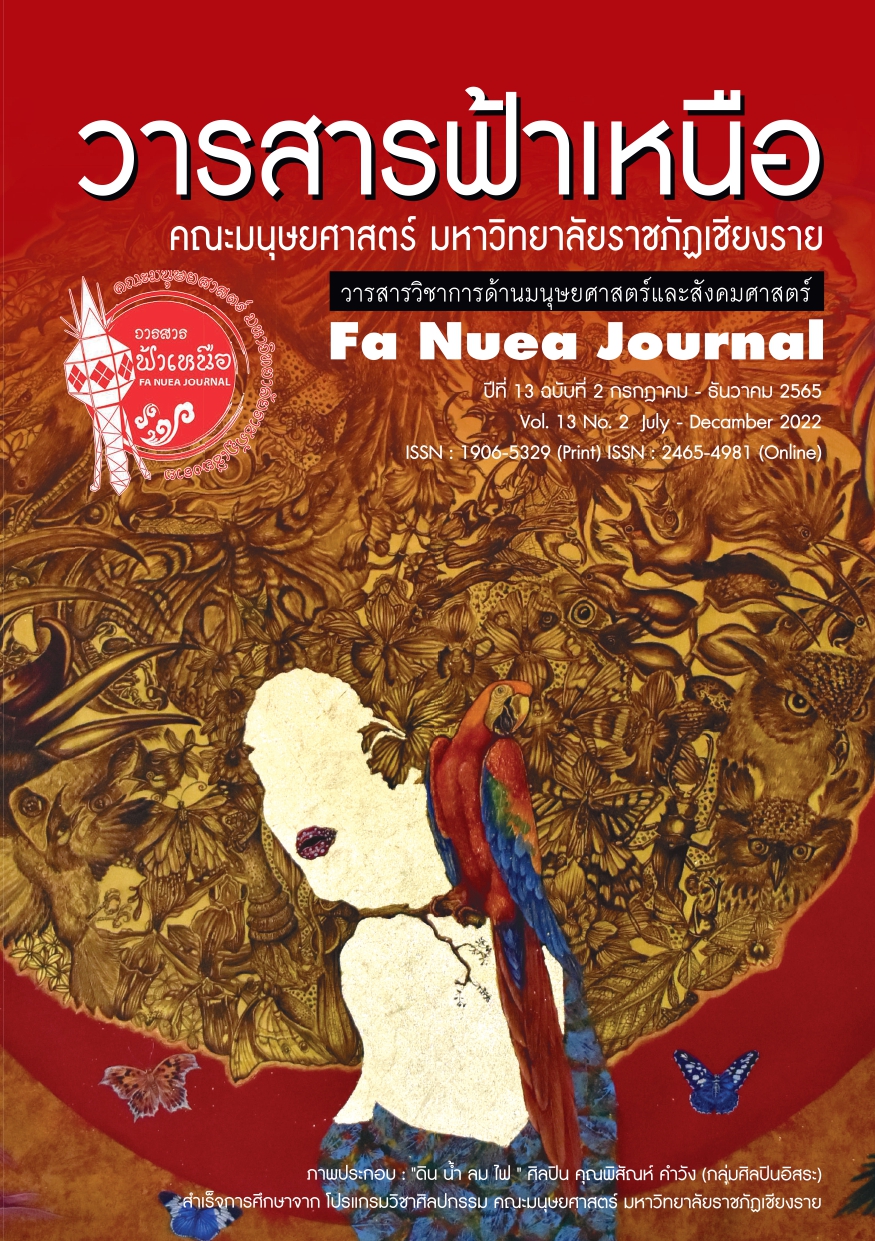ลักษณะสังคมในวรรณคดียอพระเกียรติร่วมสมัย ของไทย: ลิลิตพญางำเมือง
Main Article Content
บทคัดย่อ
บทความนี้มีวัตถุประสงค์เพื่อศึกษาลักษณะสังคมจากวรรณคดียอพระเกียรติร่วมสมัยเรื่องลิลิตพญางำเมือง โดยใช้กรอบแนวคิดการวิเคราะห์วิจารณ์ในประเด็นลักษณะสังคม ผลการศึกษาสรุปได้ว่า ลิลิตพญางำเมืองสะท้อนให้เห็นลักษณะสังคมย่อยของเมืองพะเยา ซึ่งซ้อนอยู่ในสังคมใหญ่คือสังคมล้านนาและสังคมไทย โดยมีองค์ประกอบสังคม คือ ประชากรและพื้นที่อาณาเขตของเมืองพะเยาเป็นหลัก รองลงมาคือเมืองเชียงแสน และเมืองเชียงใหม่ ส่วนพื้นที่อาณาเขตย่อย คือ เมืองละโว้หรือจังหวัดลพบุรี ดินแดนภาคกลางของไทยในปัจจุบัน ในสังคมมีสถาบันหลัก 4 สถาบัน ได้แก่ สถาบันกษัตริย์ สถาบันพุทธศาสนา สถาบันการศึกษา และสถาบันครอบครัว ส่วนด้านระเบียบแบบแผนสู่ปฏิบัติการทางสังคมพบเนื้อหาสำคัญ 5 ประการ ได้แก่ คติความเชื่อและคติธรรม ค่านิยม ดนตรีและนาฏศิลป์ ขนบประเพณี และการเมืองการปกครอง
Article Details

อนุญาตภายใต้เงื่อนไข Creative Commons Attribution-NonCommercial-NoDerivatives 4.0 International License.
เนื้อหาและข้อมูลในบทความที่ลงตีพิมพ์ในวารสารฟ้าเหนือระบบ ThaiJO2 ถือเป็นข้อคิดเห็นและความรับผิดชอบของบทความโดยตรงซึ่งกองบรรณาธิการวารสารไม่จำเป็นต้องเห็นด้วยหรือร่วมรับผิดชอบใด ๆ
บทความ ข้อมูล เนื้อหา รูปภาพ ฯลฯ ที่ได้รับการตีพิมพ์ในวารสารฟ้าเหนือระบบ ThaiJO2 ถือเป็นลิขสิทธิ์ของ วารสารฟ้าเหนือระบบ ThaiJO2 หากบุคคลหรือหน่วยงานใดต้องการนำทั้งหมดหรือส่วนหนึ่งส่วนใดไปเผยแพร่ต่อ หรือเพื่อกระทำการใดๆจะต้องได้รับอนุญาตเป็นลายลักษณ์อักษรจากวารสารฟ้าเหนือระบบ ThaiJO2 ก่อนเท่านั้น
เอกสารอ้างอิง
กาญจนา อินทรสุนานนท์. (2562). หน่วยที่ 10 นาฏศิลป์และดนตรีไทย. ในมหาวิทยาลัยสุโขทัยธรรมาธิราช สาขาวิชาศิลปศาสตร์. เอกสารการสอนชุดวิชาไทยศึกษา หน่วยที่ 8-15. (น.10-26). มหาวิทยาลัยสุโขทัยธรรมาธิราช.
เกรียงศักดิ์ ชัยดรุณ. (2549). 70 ปี พะเยาพิทยาคม. โรงเรียนพะเยาพิทยาคม.
ชาคริต อนันทราวัน. (2538). บทสูดขวัญ (จังหวัดเลย). โอเดียนสโตร์.
ณรงค์ เส็งประชา. (2539). พื้นฐานวัฒนธรรมไทย. โอเดียนสโตร์.
พัทยา สายหู. (2536). กลไกของสังคม (พิมพ์ครั้งที่ 7). จุฬาลงกรณ์มหาวิทยาลัย.
ยุพร แสงทักษิณ. (2537). วรรณคดียอพระเกียรติ. องค์การค้าของคุรุสภา.
ราชบัณฑิตยสถาน. (2556). พจนานุกรมฉบับราชบัณฑิตยสถาน พ.ศ. 2554 (พิมพ์ครั้งที่ 2). ราชบัณฑิตยสถาน.
ศุภรัตน์ เลิศพาณิชย์กุล. (2554). หน่วยที่ 1 พัฒนาการด้านประวัติศาสตร์ในดินแดนประเทศไทย. ใน มหาวิทยาลัยสุโขทัยธรรมาธิราช สาขาวิชาศิลปศาสตร์. เอกสารการสอนชุดวิชาไทยศึกษา หน่วยที่ 1-7 (น.5-6). มหาวิทยาลัยสุโขทัยธรรมาธิราช.
สำนักงานวัฒนธรรมจังหวัดพะเยา. (2559). ชาติพันธุ์ในจังหวัดพะเยา. สมาร์ทโคตติ้ง แอนด์ เซอร์วิส.
สุพัตรา สุภาพ. (2542). สังคมและวัฒนธรรมไทย ค่านิยม ครอบครัว ศาสนา ประเพณี (พิมพ์ครั้งที่ 10). ไทยวัฒนาพานิช.
สุรพล ลัดลอย. (2542, 21 สิงหาคม). บวงสรวงพ่อขุนงำเมือง พิธีกรรมแห่งความศักดิ์สิทธิ์และสามัคคี. เดลินิวส์, 25.
เสาวณิต วิงวอน. (2530). การศึกษาวิเคราะห์วรรณกรรมยอพระเกียรติ [วิทยานิพนธ์ปริญญาดุษฎีบัณฑิต, จุฬาลงกรณ์มหาวิทยาลัย]. Chulalongkorn University Intellectual Repository (CUIR). http://cuir.car.chula.ac.th/handle/123456789/67598
เสาวลักษณ์ อนันตศานต์. (2549). วรรณกรรมภาคเหนือ. มหาวิทยาลัยรามคำแหง
เอื้อ มณีรัตน์. (2538). ลิลิตพญางำเมือง. โรงเรียนพะเยาพิทยาคม.


